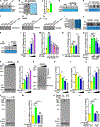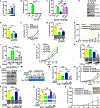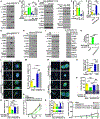NSUN2 is a glucose sensor suppressing cGAS/STING to maintain tumorigenesis and immunotherapy resistance
- PMID: 37586363
- PMCID: PMC10726430
- DOI: 10.1016/j.cmet.2023.07.009
NSUN2 is a glucose sensor suppressing cGAS/STING to maintain tumorigenesis and immunotherapy resistance
Abstract
Glucose metabolism is known to orchestrate oncogenesis. Whether glucose serves as a signaling molecule directly regulating oncoprotein activity for tumorigenesis remains elusive. Here, we report that glucose is a cofactor binding to methyltransferase NSUN2 at amino acid 1-28 to promote NSUN2 oligomerization and activation. NSUN2 activation maintains global m5C RNA methylation, including TREX2, and stabilizes TREX2 to restrict cytosolic dsDNA accumulation and cGAS/STING activation for promoting tumorigenesis and anti-PD-L1 immunotherapy resistance. An NSUN2 mutant defective in glucose binding or disrupting glucose/NSUN2 interaction abolishes NSUN2 activity and TREX2 induction leading to cGAS/STING activation for oncogenic suppression. Strikingly, genetic deletion of the glucose/NSUN2/TREX2 axis suppresses tumorigenesis and overcomes anti-PD-L1 immunotherapy resistance in those cold tumors through cGAS/STING activation to facilitate apoptosis and CD8+ T cell infiltration. Our study identifies NSUN2 as a direct glucose sensor whose activation by glucose drives tumorigenesis and immunotherapy resistance by maintaining TREX2 expression for cGAS/STING inactivation.
Keywords: NSUN2; STING; T cell infiltration; TREX2; cGAS; glucose; immunotherapy resistance; m(5)C RNA methylation.
Copyright © 2023 Elsevier Inc. All rights reserved.
Conflict of interest statement
Declaration of interests H.-K.L. is a consultant for Stablix, Inc.
Figures







References
Publication types
MeSH terms
Substances
Grants and funding
LinkOut - more resources
Full Text Sources
Research Materials
Miscellaneous

